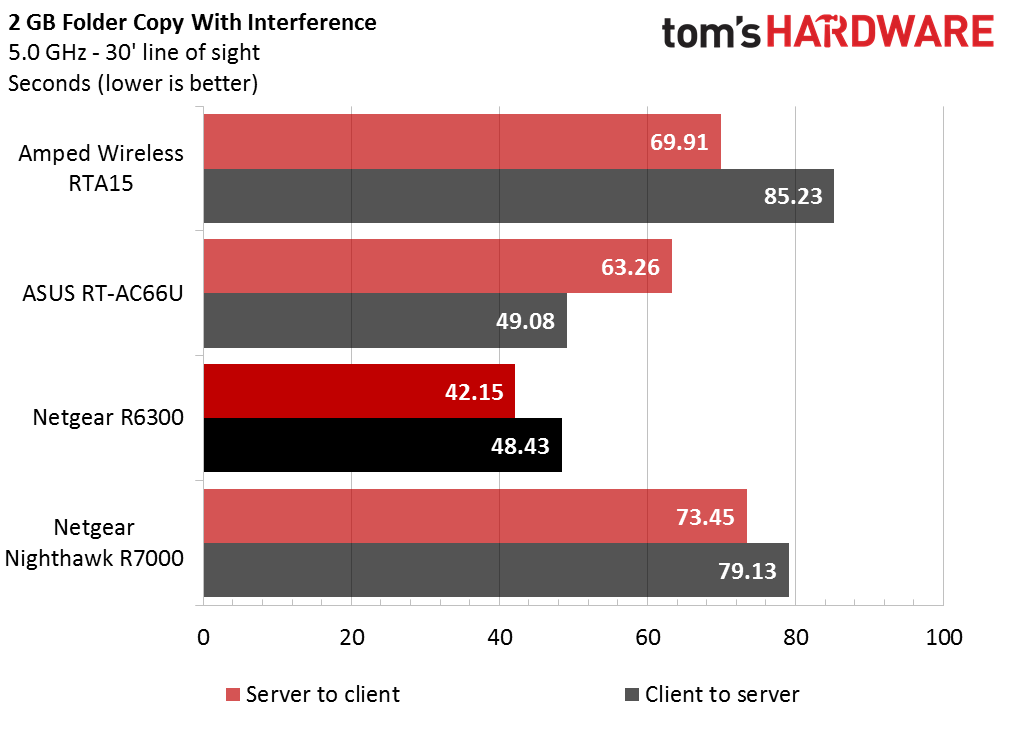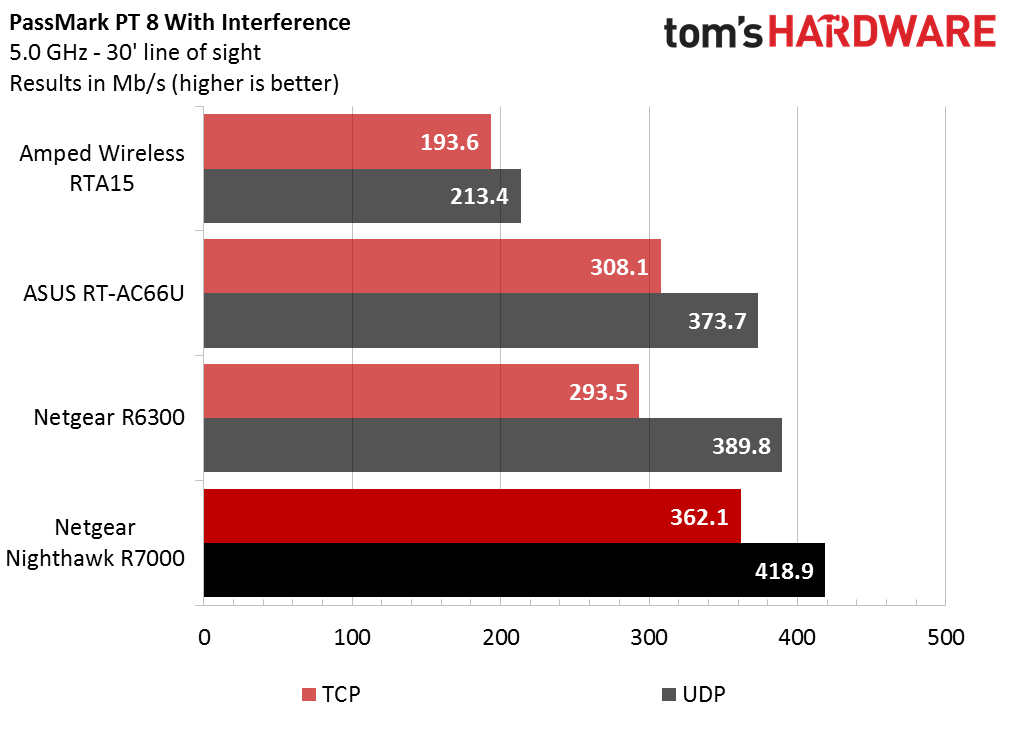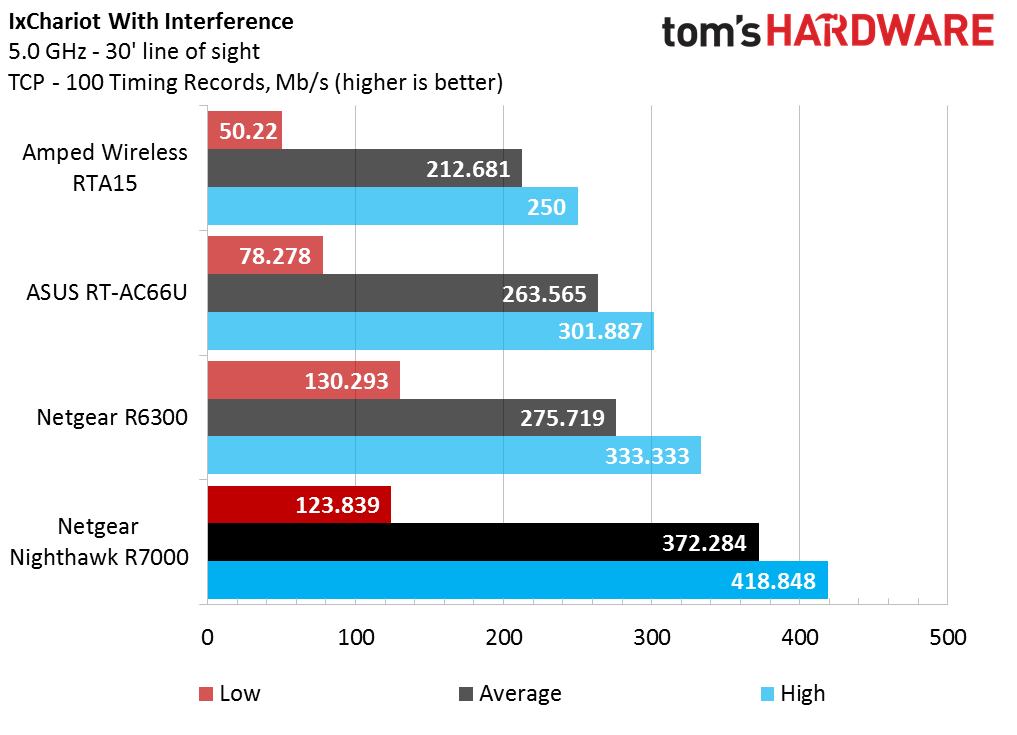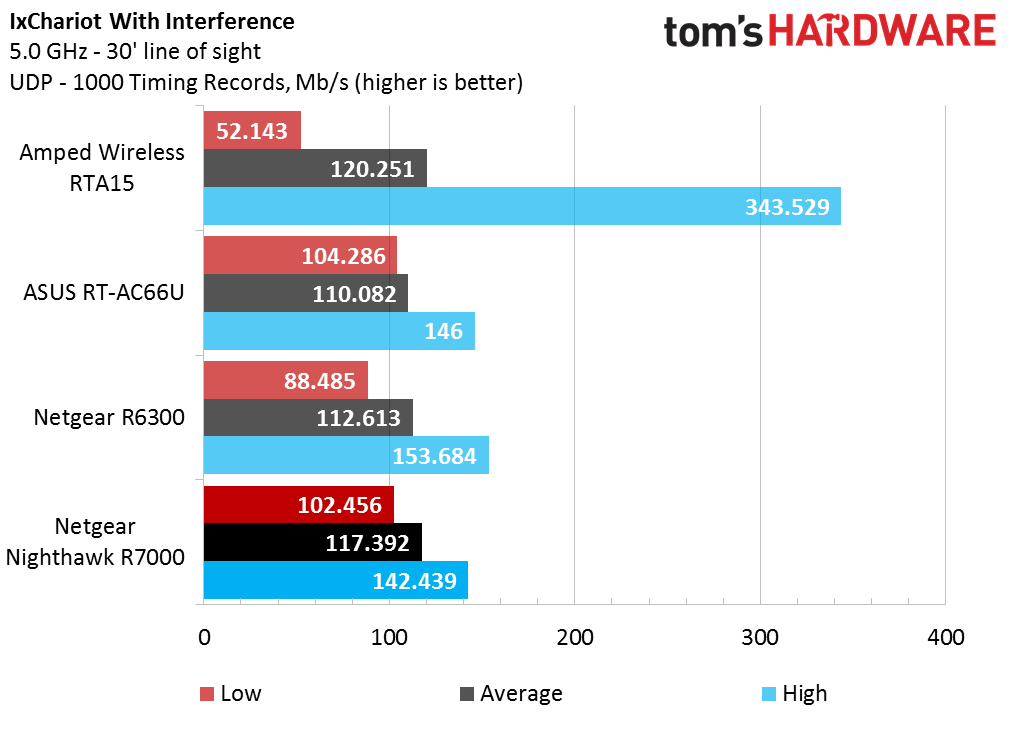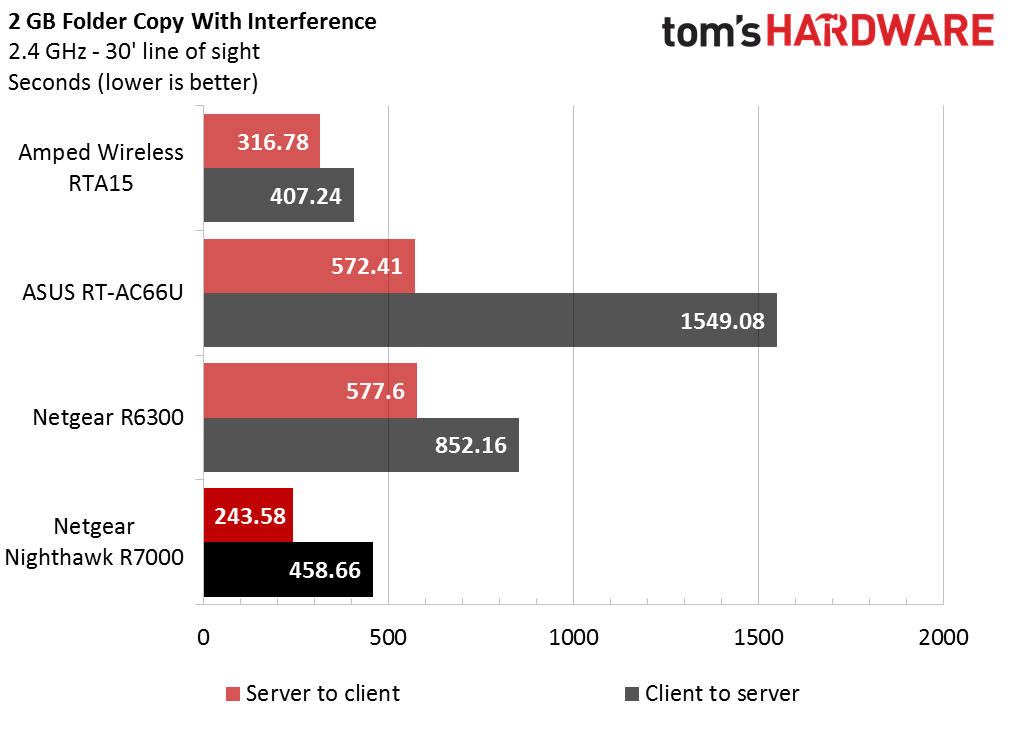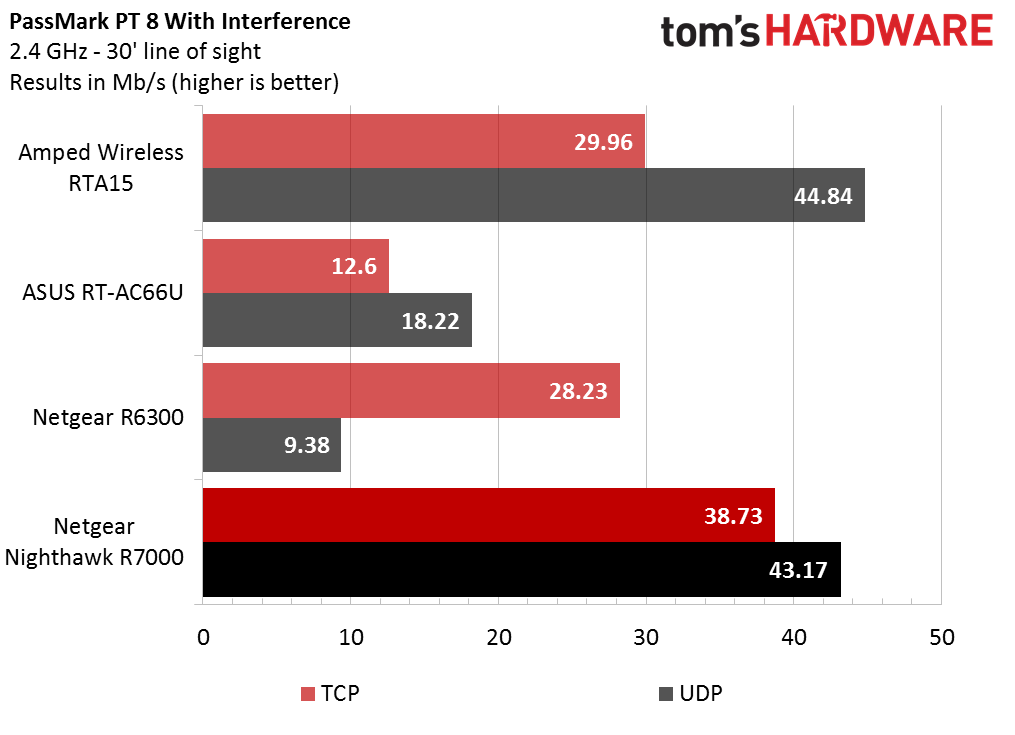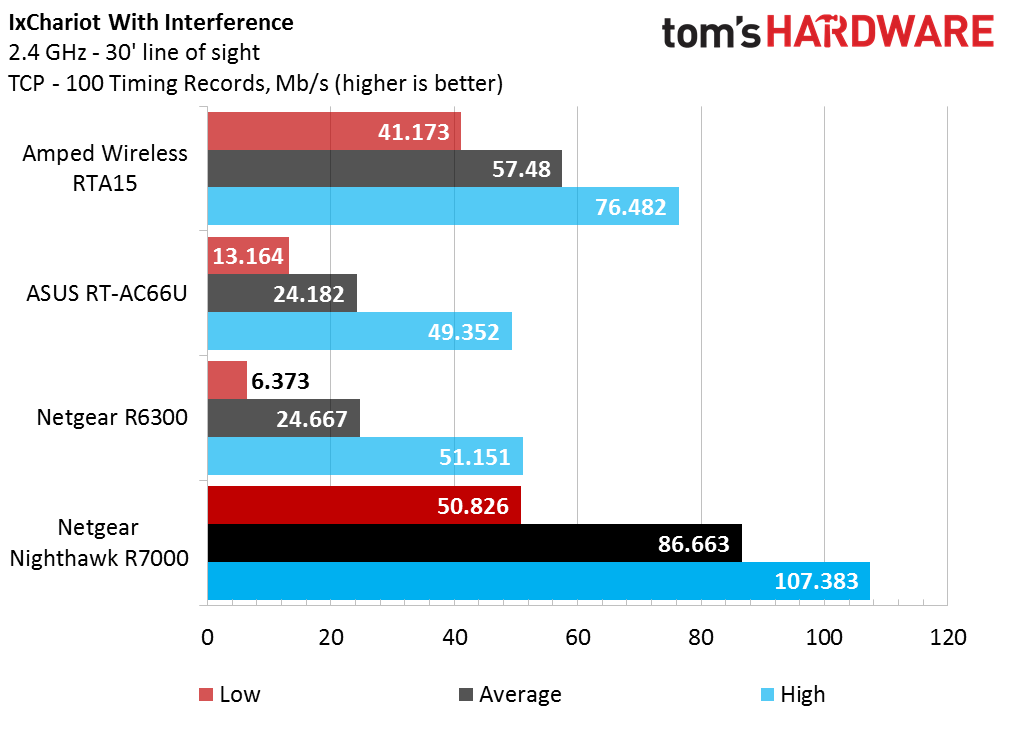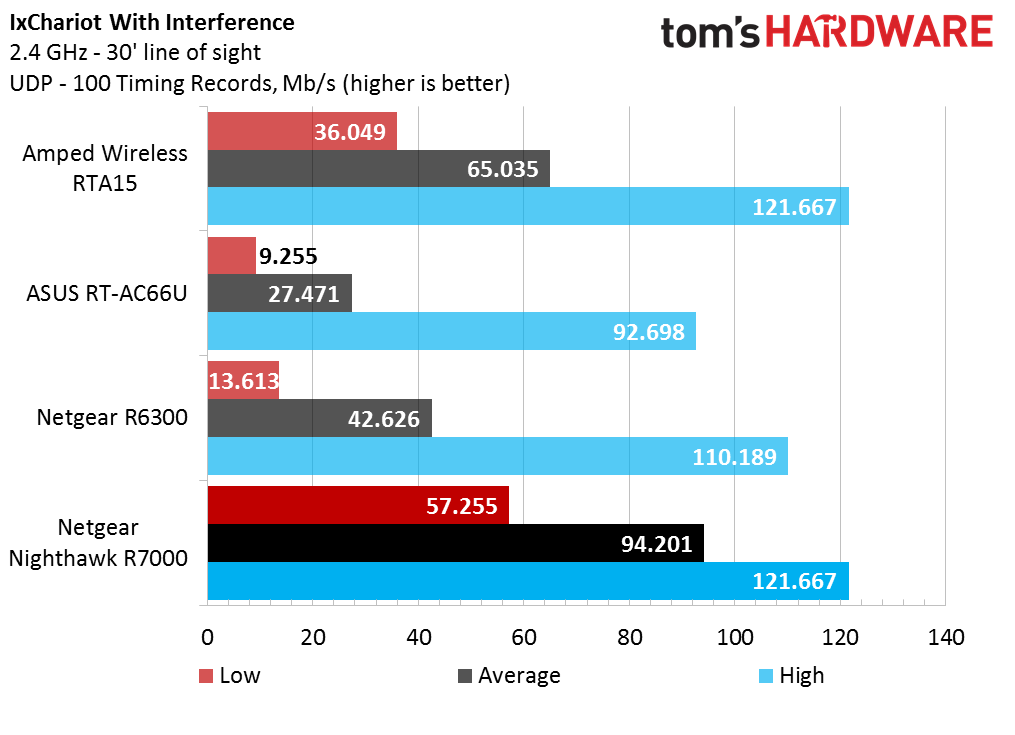802.11ac Wi-Fi Router Testing: Interference And Workloads
Performance With Interference
Now things start to get interesting. We wanted to examine the role of interference in 11ac throughput. Obviously, there are many ways to go about this, from industrial-grade RF emitters to the kitchen microwave oven. For the sake of simplicity and reproduction, we decided to use one of our spare routers as an interfering source. Specifically, we set the Nighthawk up as a client adapter on the same channel frequency, plugged it into a client notebook and set it on the table about two feet from the router under test directly in the line of sight path between test router and client adapter on the other side of the room. When we test the Nighthawk, we use the Asus as our interfering client. We then had the interfering router pull in a continuous Netflix stream from the home network. Given the multi-path nature of MIMO, we clearly couldn’t disrupt all paths into the test router, but this approach seemed like it should provide at least some competition for our test subjects and apply some stress on their ability to cope with competing ambient traffic.
Again, we’ll run the baseline results next to the current test results for comparison. In three out of four cases, performance declined in the face of 5GHz interference. Strangely, the exception was our R6300, which picked up a roughly 15% performance gain on server-to-client transferring. Everybody else seems to have suffered from the RF competition. Amped and the Nighthawk in particular appear to have been hit hardest.
In our PassMark test, every router loses performance. Recall that our baseline showed us hitting that 410-ish Mb/s ceiling, especially in UDP throughput. With interference, only the Nighthawk can keep scratching that UDP maximum. Every other score suffers, including the Nighthawk’s TCP speed. This time around, the Amped router seems particularly wounded. Combined with the 2GB test, this has us starting to wonder if Amped’s 2x2 antenna design leaves it more susceptible to 5GHz environmental issues.
We see another anomaly here with the Nighthawk battling through interference from the R63000 to pull in even faster numbers, albeit not stunningly accelerated. The R6300 sees some elevation in its performance floor, but the reduction in its ceiling yields a slower overall average. The Amped and Asus units get hammered particularly hard by 5GHz interference.
As one might expect from UDP, in which there’s no mandate to resend failed packets, we see very little difference in our baseline and interference results. In fact, here you can see the Nighthawk’s 5GHz IxChariot graph results, with the interference results shown on the right.
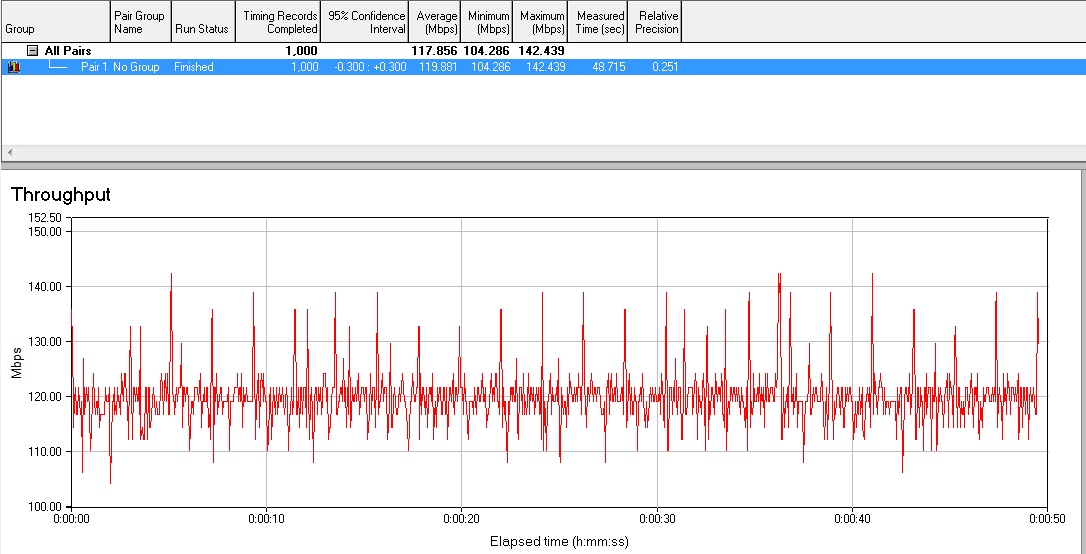

Very similar, right? The interfered pattern shows a bit less spiking up toward 140 Mb/s, but otherwise the graph seems little affected.
Let’s see if these results carry over into our 2.4GHz interference comparisons.
Get Tom's Hardware's best news and in-depth reviews, straight to your inbox.
Right off the bat, we would answer no. TCP traffic gets mauled like a bear victim with a broken leg. Why, you think, there’s no way that Asus could really take almost 1550 seconds to complete the client-to-server test. That’s nearly half an hour! Yes, Marsha, it’s true. We ran it twice. The Nighthawk won this race simply by being the only router to have one result that didn’t double or triple from our baseline.
The bad news is only confirmed by PassMark. All routers take it in the kidneys. Our beloved AC66U from the prior round-up sees its UDP traffic in particular crushed. The Nighthawk again wins through sheer force of staying upright throughout the interference storm.
Again, be careful of the x-axis scale; it could be misleading. Amped may have won our baseline test for 2.4GHz TCP in IxChariot, but in the face of interference it loses roughly two-thirds of its throughput. Asus likewise wears a boat anchor into the dark depths. Damage for the R6300 isn’t as relatively bad, but, then again, it had less to lose when starting in last place. By only sacrificing about 20%, the Nighthawk looks downright awesome.
Check out the instant replay. TCP or UDP, the impact of interference on the 2.4GHz band remains almost the same. Again, the Nighthawk withstands assault well, and the Asus serves as a warning for future generations. Just look at the Asus' comparison between baseline (left) and interfered here.
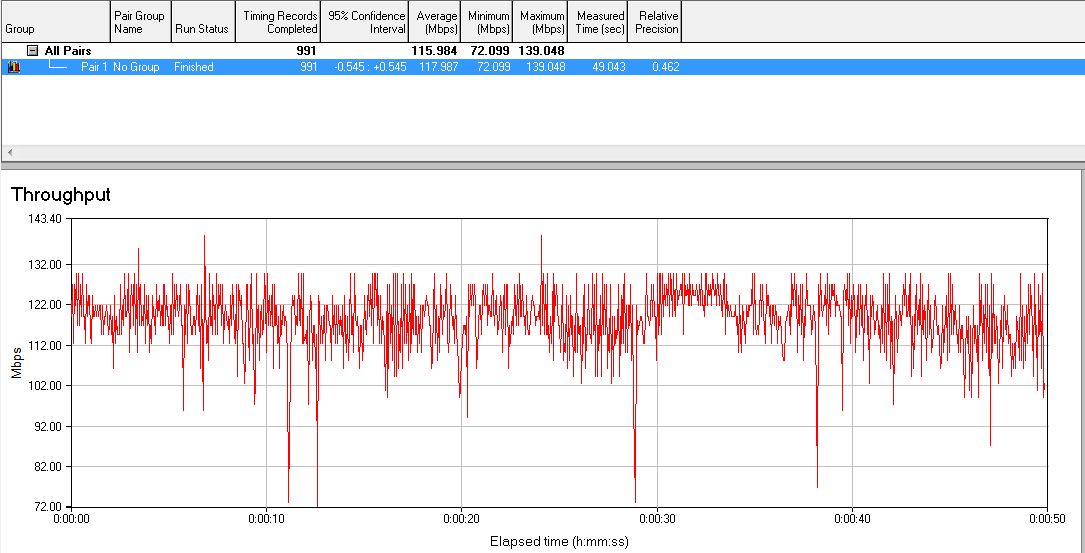
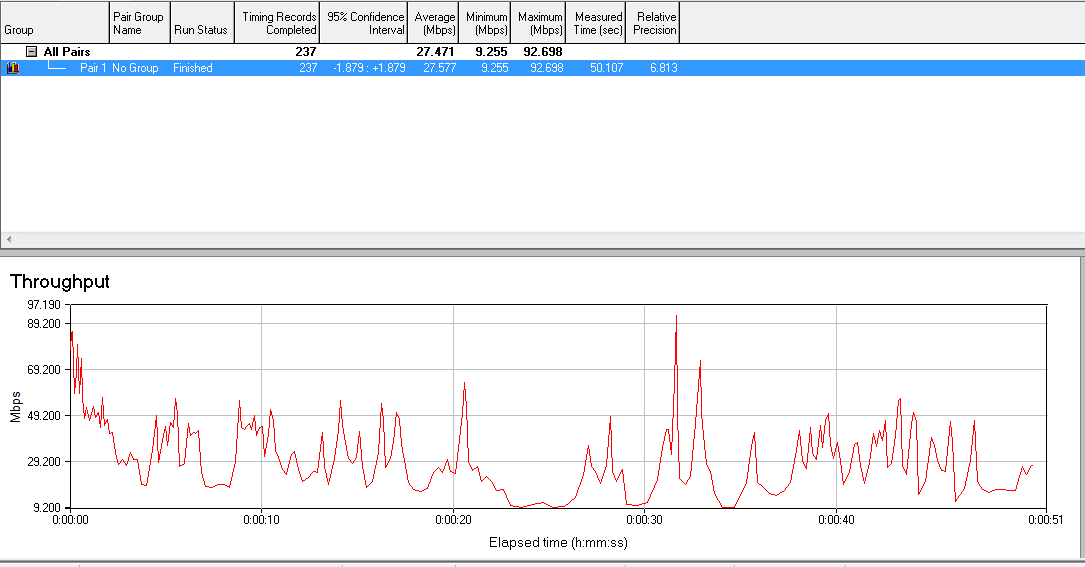
Current page: Performance With Interference
Prev Page Performance Without Encryption Next Page Performance Over Range-
jacobian In "How we tested" you didn't specify what kind of wi-fi hardware the test clients had. Was it PCIe or USB network adapter? What kind of MIMO setup, e.g. 3x3 or 2x2?Reply
-
chimera201 I would like to see tear-down of routers to see the components for making a guess at longevity.Reply -
CaedenV This was a much better test setup, and a really interesting read. Only complaint was that the nighthawk may have an unfair advantage in the interferance tests compared to the other units as it went up against the 66U instead of another nighthawk. Perhaps you could dig up a 5GHz N router to act as a standard interference device next time? Or find a cheap AC router? It would make it a much better apples-to-apples comparison.Reply
At any rate, great article! I will certainly send this to my more tech-savvy friends who are looking to upgrade from N right now. I have the 66U in my own home and this seems to be spot-on which what I experience relating to distance and obstructions. It is not necessarily the fastest router on the market, but it is nice an consistent which has merits. -
dgingeri Home router security is so poor, I wouldn't even think of using one. Let me guess, they all have WPS, right? HUGE security hole that nobody ha made one little tiny step in fixing, and is "featured" on nearly every home router.Reply -
Larry Litmanen I use to have constant WiFi issues, one day i went out and got the best router i could, still had issues. Calling them for support was hell, 45 minutes on the phone just to be told "Sorry sir but there's nothing wrong with our router, your internet is down".Reply
I found out that my cable/internet company provides a free router, they hooked it up..............no issues since. Heck they just gave me a free AC router that can be controlled from internet.
I will not be buying any more routers. -
@dgingeri, I've never seen a router that didn't have the option to disable WPS. And WPS is better than nothing for non-technical people.Reply
Cool article. -
dgingeri Reply15852608 said:@dgingeri, I've never seen a router that didn't have the option to disable WPS. And WPS is better than nothing for non-technical people.
Cool article.
WPS can't be turned disabled by software. That's the big problem with it. My last two routers and one AP got hacked through WPS, even though it was disabled in software. That's when I learned that it doesn't actually get turned off. The only way to protect against the WPS security hole is if the software running the router or AP doesn't support WPS. This can be done by either getting an AP or router without that feature (quite difficult and rather expensive) or putting an opensource software on your router that doesn't have support for WPS (more difficult, but somewhat less expensive.)
As for "better than nothing for non-technical people", that's pretty much asinine. That's like saying "someone can't operate the key, so we'll leave this side door open." -
dgingeri Reply15852434 said:I use to have constant WiFi issues, one day i went out and got the best router i could, still had issues. Calling them for support was hell, 45 minutes on the phone just to be told "Sorry sir but there's nothing wrong with our router, your internet is down".
I found out that my cable/internet company provides a free router, they hooked it up..............no issues since. Heck they just gave me a free AC router that can be controlled from internet.
I will not be buying any more routers.
Did you know the ISP free routers have a back door for support purposes. They couldn't support them if they didn't have that back door. The big problem with that is that every support person, and former support person, for that company knows that back door. A vengeful or malicious former employee could easily hack into any customer's router and insert tracking software or "listen in" on the internet traffic, capturing all your passwords. They also have other massive security holes. ISPs patch their router firmware for bugs or security holes even less often than home router manufacturers. They aren't safe.
-
liquidpower this is the most important part of the Client how could you not included it?ReplyIn "How we tested" you didn't specify what kind of wi-fi hardware the test clients had. Was it PCIe or USB network adapter? What kind of MIMO setup, e.g. 3x3 or 2x2?
-
bikeracer4487 So in the "Performance without Encryption" section, in the very first test you test how long it takes to copy a 2GB folder, with the results measured in seconds. The AC66U wins with the lowest time, and the R6300 having the SLOWEST time...and yet you wrote this: "The exception is the R6300, which takes a 10% to 20% jump. This is a strong enough leap to propel it into first place in our test. Could it be that the R6300 is in fact a far more capable speedster being held back by encryption processing? Or is it just luck and variable ambient test conditions?"Reply
